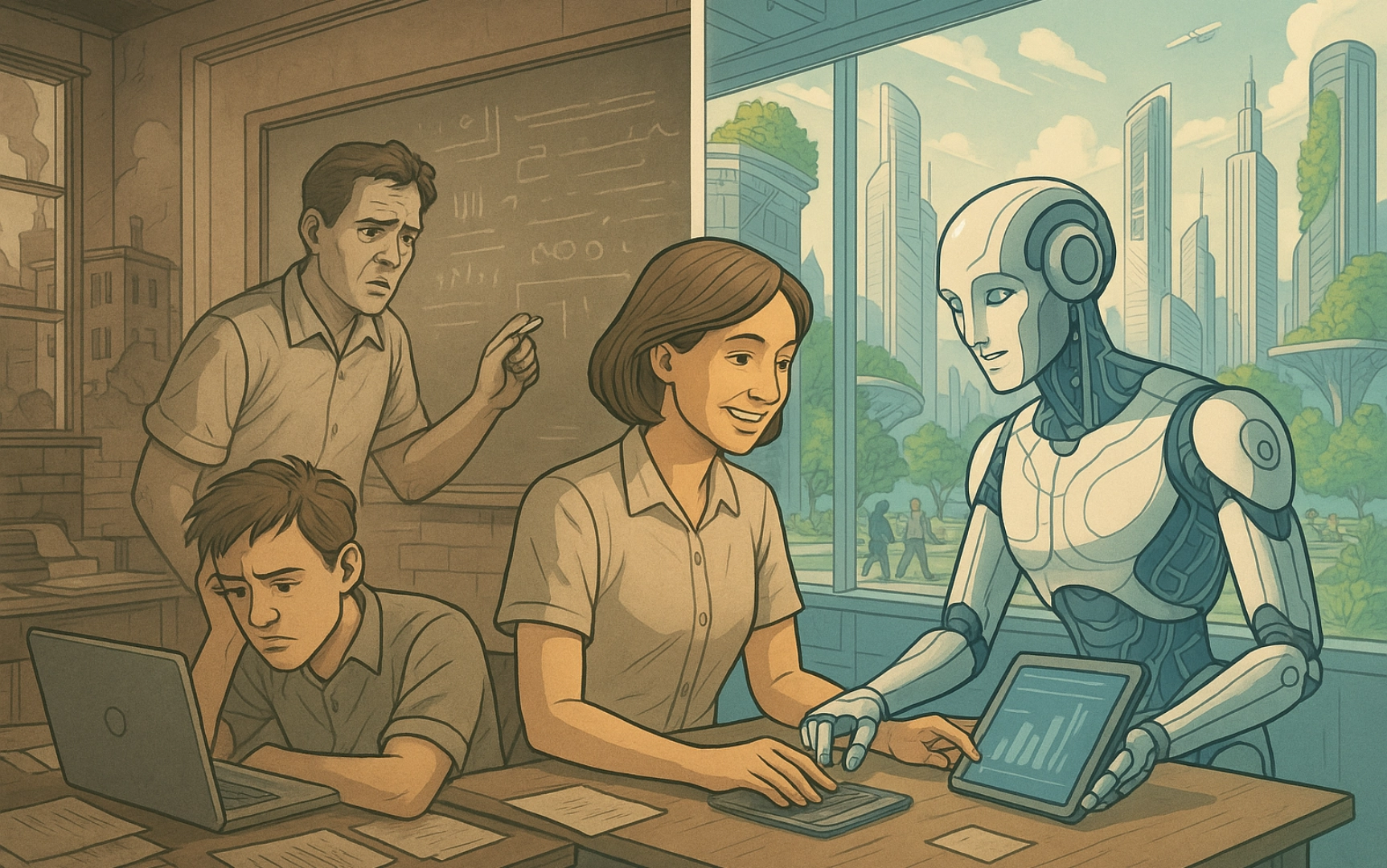

Assisted Intelligence: Rethinking AI’s Role in Humanity’s Future
What if AI isn’t artificial, but assisted? A new way of seeing intelligent systems—not as replacements, but as partners in human progress.
Artificial Intelligence (AI) has rapidly shifted from science fiction fantasy to an integral part of our everyday lives. From OpenAI’s ChatGPT, which has transformed communication and education, to Google DeepMind’s AlphaFold, which has revolutionized biomedical research, AI’s pervasive reach is undeniable.
Yet, with its rise comes growing concern—vocational displacement, ethical dilemmas, and cultural shifts. It’s important to acknowledge that AI can feel overwhelming for those without access to reliable information or digital literacy. Without thoughtful implementation, it could lead to a deterioration of human ability, social interaction, and possible means of income for many.
But what if we reframe AI not as a threat, but as a symbiotic partner? What if, instead of “Artificial Intelligence,” we embraced the idea of Assisted Intelligence—a collaborator that enhances human capability, not replaces it?
The Human Condition: Our Irreplaceable Contribution
At the core of every society is the human condition—a blend of ethics, creativity, culture, and emotion that code cannot replicate. While tools like Midjourney or DALL·E 3 can generate striking images, they still rely on human prompts rooted in lived experience, aesthetic taste, and moral context.
In healthcare, AI, like specialized models drawing on capabilities similar to GPT-4, can rapidly analyze vast medical records, assisting in the early identification of patterns indicative of rare diseases far quicker than human doctors could manually. Yet it takes a human physician to understand a patient’s fears, lifestyle, and emotional readiness for treatment. The human touch remains paramount in building trust and delivering compassionate care.
Creativity, too, remains deeply human. AI can generate symphonies or scripts, but the resonance of a song like Billie Eilish’s “What Was I Made For?” or the layered satire in Jordan Peele’s films can’t be generated by code—they’re the product of culture, emotion, and identity. AI might be a powerful tool, but it’s the human experience that gives art its meaning and impact.
AI as an Extension, Not a Replacement
We are not facing a zero-sum game. AI is an amplifier, not a usurper. Think of GitHub Copilot: it doesn’t replace software engineers—it helps them code faster, debug smarter, and prototype ideas more rapidly. In writing, tools like Grammarly or Notion AI streamline drafting, but it’s the human voice that gives content soul.
Real-world examples showcasing AI’s assistance:
- Healthcare: Beyond diagnosis, AI-powered systems are assisting in drug discovery, significantly accelerating the identification of potential compounds and reducing development time. For instance, Insilico Medicine has used AI to identify a novel target and design a new drug for idiopathic pulmonary fibrosis, which is now in clinical trials.
- Education: Khanmigo (from Khan Academy) offers AI-powered tutoring tailored to each student’s learning style, providing personalized support and freeing up teachers to focus on deeper engagement and individual student needs.
- Journalism: Bloomberg uses its “Cyborg” AI to generate earnings reports within seconds—yet humans still write the investigative pieces that require critical analysis, storytelling, and nuanced understanding of events. Similarly, many news organizations are using AI for content summarization and data analysis, allowing journalists to uncover insights faster.
- Law: Legal tech like Harvey (powered by OpenAI) drafts legal memos and conducts legal research, but lawyers interpret the nuance, strategize, and represent clients in court, where human judgment and empathy are critical.
- Customer Service: AI-powered chatbots and virtual assistants handle routine inquiries, allowing human agents to focus on complex issues requiring problem-solving and emotional intelligence. Companies like Genesys are integrating AI to route calls more efficiently and provide agents with real-time information.
- Agriculture: AI is being used in precision agriculture to monitor crop health, predict yields, and optimize irrigation, helping farmers make data-driven decisions to increase efficiency and sustainability. Companies like John Deere are incorporating AI into their equipment for autonomous operations and data analysis.
The Vocational Shift, Not Demise
The World Economic Forum’s Future of Jobs Report 2023 predicts that by 2027, AI and technological advancement will displace 83 million jobs while simultaneously creating 69 million new ones. This signifies a significant reshuffling of the workforce, rather than a net loss of opportunity. Think of AI ethicists, prompt engineers, digital empathy trainers, AI UX designers, and synthetic data specialists. This isn’t job elimination; it’s job evolution.
History echoes this trend. When the ATM was introduced, bank teller jobs shifted from routine transactions to customer relations. The same shift is happening now—from doing the task to managing, curating, or humanizing the task with AI.
What matters is preparation. Reskilling initiatives like Microsoft’s AI Skills Initiative or Google’s Career Certificates show how companies and governments can guide this evolution. Education must now include AI literacy, critical thinking, and emotional intelligence to equip the workforce for this new collaborative paradigm.
A Partnership Model for the Future
The future isn’t AI versus humanity—it’s AI alongside humanity. According to researchers at MIT and Stanford’s 2024 AI Index, collaborative models (human-AI teams) consistently outperform either party working alone in areas like diagnosis, logistics, and even strategy games like StarCraft.
Looking 30 years ahead, the partnership paradigm could redefine global systems. Online sources and expert predictions suggest a future where AI is deeply integrated but always in service of human objectives:
- Healthcare (2055): AI could become an invisible layer of proactive health. Imagine nanotech wearables and implantable sensors continuously monitoring biomarkers, powered by AI to pre-screen for diseases with incredible accuracy, years before symptoms appear. Doctors would then shift their focus almost entirely to preventive wellness, personalized lifestyle interventions, and fostering deep patient trust and emotional support, leveraging AI for predictive analytics on treatment efficacy and patient outcomes. The emphasis would move from treating illness to maintaining holistic well-being.
- Climate Action (2055): AI will be instrumental in complex environmental modeling. We could see sophisticated AI simulations predicting the precise impact of different climate interventions (e.g., carbon capture technologies, reforestation strategies, geoengineering proposals) before policies are enacted. This would allow for evidence-based decision-making on a global scale, optimizing resource allocation and minimizing unintended consequences. AI could also manage intricate smart grids for renewable energy and coordinate autonomous ecological restoration efforts.
- Urban Planning & Infrastructure (2055): AI will optimize every aspect of urban living. Think of AI-driven traffic management systems that virtually eliminate congestion, smart city platforms that manage waste collection, energy distribution, and public safety in real-time. AI could also design and manage adaptive infrastructure that responds to environmental changes and population shifts, leading to more sustainable and livable cities.
- Education (2055): Personalized learning will reach unprecedented levels. AI tutors will adapt to individual brainwave patterns and emotional states, creating hyper-customized curricula that maximize learning efficiency and engagement. Human educators will act as mentors, guiding critical thinking, fostering creativity, and nurturing socio-emotional development, becoming facilitators of profound learning experiences rather than just dispensers of information.
- Scientific Discovery (2055): AI will act as an omnipresent research assistant, automating hypotheses generation, experimental design, and data analysis in fields from materials science to astrophysics. This could lead to a rapid acceleration of breakthroughs, as AI identifies novel patterns and connections that human minds might miss. Expect new materials with unprecedented properties and fundamental discoveries about the universe, driven by AI-accelerated research.
- Faith & Ethics (2055): While inherently human, AI could become a tool for moral forecasting. Human leaders may use advanced AI models to simulate the societal and theological consequences of various ethical dilemmas or policy decisions—a kind of moral sandbox that could predict public sentiment shifts, analyze historical moral precedents, or forecast long-term societal impacts. This wouldn’t replace human conscience but would provide invaluable data to inform complex moral reasoning, still led by human wisdom and values.
But this future requires ethical frameworks. The EU AI Act (2024) and UNESCO’s AI Ethics Guidelines are early steps, but we must go further. Every algorithm must serve a human purpose, not just profit. Developing globally harmonized AI governance will be crucial to ensure these advanced systems are developed and deployed responsibly.
Final Thoughts
If we embrace AI as Assisted Intelligence, we don’t lose control—we regain perspective. We strip away the fear of obsolescence and reveal a new narrative: one where AI is the hammer, and humanity is the hand that wields it.
The question is not, “Will AI replace us?” but “How will we lead it?”
In this light, AI doesn’t diminish us. It elevates us—if we remain human first, and human-led. The coming decades will not be about humans versus machines, but about the unparalleled synergy created when human ingenuity is augmented by intelligent systems. It is our collective responsibility to guide this evolution towards a future where AI serves humanity’s highest aspirations.
Sources
Learn more and verify the information in this article through the following sources: 🔗 [Source Here]
This article was written by Ken Paul, with the assistance of NovaGPT—an AI writing tool used to enhance research, structure, and clarity.